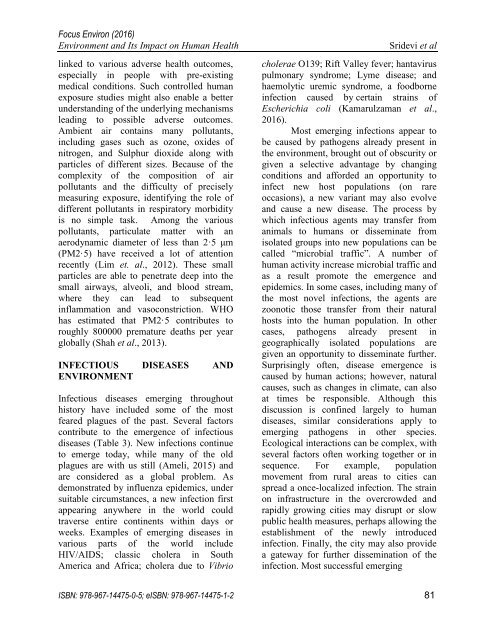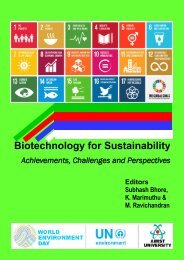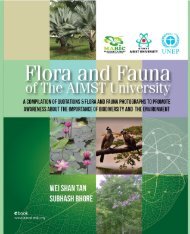Focus on Environment
This book is the Proceedings of the ‘National Seminar on Sustainable Environment and Health 2016’ & ‘World Environment Day-2016 (WED-2016)’ events held on the campus of AIMST University, Kedah, Malaysia. ISBN: 978-967-14475-0-5 (Print version); eISBN: 978-967-14475-1-2 (e-Book version) Editors Subhash Bhore & K. Marimuthu
This book is the Proceedings of the ‘National Seminar on Sustainable Environment and Health 2016’ & ‘World Environment Day-2016 (WED-2016)’ events held on the campus of AIMST University, Kedah, Malaysia.
ISBN: 978-967-14475-0-5 (Print version); eISBN: 978-967-14475-1-2 (e-Book version)
Editors
Subhash Bhore & K. Marimuthu
Create successful ePaper yourself
Turn your PDF publications into a flip-book with our unique Google optimized e-Paper software.
<str<strong>on</strong>g>Focus</str<strong>on</strong>g> Envir<strong>on</strong> (2016)<br />
Envir<strong>on</strong>ment and Its Impact <strong>on</strong> Human Health<br />
linked to various adverse health outcomes,<br />
especially in people with pre-existing<br />
medical c<strong>on</strong>diti<strong>on</strong>s. Such c<strong>on</strong>trolled human<br />
exposure studies might also enable a better<br />
understanding of the underlying mechanisms<br />
leading to possible adverse outcomes.<br />
Ambient air c<strong>on</strong>tains many pollutants,<br />
including gases such as oz<strong>on</strong>e, oxides of<br />
nitrogen, and Sulphur dioxide al<strong>on</strong>g with<br />
particles of different sizes. Because of the<br />
complexity of the compositi<strong>on</strong> of air<br />
pollutants and the difficulty of precisely<br />
measuring exposure, identifying the role of<br />
different pollutants in respiratory morbidity<br />
is no simple task. Am<strong>on</strong>g the various<br />
pollutants, particulate matter with an<br />
aerodynamic diameter of less than 2·5 μm<br />
(PM2·5) have received a lot of attenti<strong>on</strong><br />
recently (Lim et. al., 2012). These small<br />
particles are able to penetrate deep into the<br />
small airways, alveoli, and blood stream,<br />
where they can lead to subsequent<br />
inflammati<strong>on</strong> and vasoc<strong>on</strong>stricti<strong>on</strong>. WHO<br />
has estimated that PM2·5 c<strong>on</strong>tributes to<br />
roughly 800000 premature deaths per year<br />
globally (Shah et al., 2013).<br />
INFECTIOUS DISEASES AND<br />
ENVIRONMENT<br />
Infectious diseases emerging throughout<br />
history have included some of the most<br />
feared plagues of the past. Several factors<br />
c<strong>on</strong>tribute to the emergence of infectious<br />
diseases (Table 3). New infecti<strong>on</strong>s c<strong>on</strong>tinue<br />
to emerge today, while many of the old<br />
plagues are with us still (Ameli, 2015) and<br />
are c<strong>on</strong>sidered as a global problem. As<br />
dem<strong>on</strong>strated by influenza epidemics, under<br />
suitable circumstances, a new infecti<strong>on</strong> first<br />
appearing anywhere in the world could<br />
traverse entire c<strong>on</strong>tinents within days or<br />
weeks. Examples of emerging diseases in<br />
various parts of the world include<br />
HIV/AIDS; classic cholera in South<br />
America and Africa; cholera due to Vibrio<br />
Sridevi et al<br />
cholerae O139; Rift Valley fever; hantavirus<br />
pulm<strong>on</strong>ary syndrome; Lyme disease; and<br />
haemolytic uremic syndrome, a foodborne<br />
infecti<strong>on</strong> caused by.certain strains of<br />
Escherichia coli (Kamarulzaman et al.,<br />
2016).<br />
Most emerging infecti<strong>on</strong>s appear to<br />
be caused by pathogens already present in<br />
the envir<strong>on</strong>ment, brought out of obscurity or<br />
given a selective advantage by changing<br />
c<strong>on</strong>diti<strong>on</strong>s and afforded an opportunity to<br />
infect new host populati<strong>on</strong>s (<strong>on</strong> rare<br />
occasi<strong>on</strong>s), a new variant may also evolve<br />
and cause a new disease. The process by<br />
which infectious agents may transfer from<br />
animals to humans or disseminate from<br />
isolated groups into new populati<strong>on</strong>s can be<br />
called “microbial traffic”. A number of<br />
human activity increase microbial traffic and<br />
as a result promote the emergence and<br />
epidemics. In some cases, including many of<br />
the most novel infecti<strong>on</strong>s, the agents are<br />
zo<strong>on</strong>otic those transfer from their natural<br />
hosts into the human populati<strong>on</strong>. In other<br />
cases, pathogens already present in<br />
geographically isolated populati<strong>on</strong>s are<br />
given an opportunity to disseminate further.<br />
Surprisingly often, disease emergence is<br />
caused by human acti<strong>on</strong>s; however, natural<br />
causes, such as changes in climate, can also<br />
at times be resp<strong>on</strong>sible. Although this<br />
discussi<strong>on</strong> is c<strong>on</strong>fined largely to human<br />
diseases, similar c<strong>on</strong>siderati<strong>on</strong>s apply to<br />
emerging pathogens in other species.<br />
Ecological interacti<strong>on</strong>s can be complex, with<br />
several factors often working together or in<br />
sequence. For example, populati<strong>on</strong><br />
movement from rural areas to cities can<br />
spread a <strong>on</strong>ce-localized infecti<strong>on</strong>. The strain<br />
<strong>on</strong> infrastructure in the overcrowded and<br />
rapidly growing cities may disrupt or slow<br />
public health measures, perhaps allowing the<br />
establishment of the newly introduced<br />
infecti<strong>on</strong>. Finally, the city may also provide<br />
a gateway for further disseminati<strong>on</strong> of the<br />
infecti<strong>on</strong>. Most successful emerging<br />
ISBN: 978-967-14475-0-5; eISBN: 978-967-14475-1-2 81







